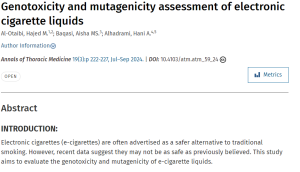The popularity of ecigarettes and other vaping products in recent years has raised questions about their potential dangers, especially for teenagers.
Although these products were initially promoted as a safer substitute for conventional tobacco products, accumulating data indicates that they pose serious risks to young people’s developing brains.
Due to their appealing flavours, slick designs and false representation as “cool” or “harmless” alternatives, ecigarettes and other vaping products have become incredibly popular among teenagers.
These devices are frequently freely accessible and readily available to those who are underage, which contributes to their rising usage rates.
Malaysia has emerged as one of South-East Asia’s fastest-growing ecigarette markets, with projections of a million regular ecigarette users.
From 0.8% (15 years old and above) in 2011 to 3.2% (18 years old and above) in 2016, to 4.9% (15 years old and above) in 2019 to 5.4% (18 years old and above) in 2020, Malaysia has seen an increase in the prevalence of ecigarette usage among Malaysian teenagers and adults.
Through advancement in research, we are beginning to understand that adolescence is a unique development period, which includes development of emotion, cognition and social skills.
These are influenced by many factors, such as genes, environment, nutrition, sleep patterns, drugs (medical and recreational) and sex hormones.
During this period, the brain goes through dramatic structural and functional changes.
The reward system – a specific component within the limbic system that is involved in experiencing pleasure, reinforcement and motivation – is highly sensitive to rewards during this period.
The limbic system – a collection of brain regions that regulate reward and emotion – undergoes major changes at the onset of puberty.
Whereas, the prefrontal cortex, which is involved in decision-making, planning, organisation and control of impulses, does not fully develop until the mid-20s.
The mismatch between the development of cortical and subcortical structures make adolescents more susceptible to risky behaviour.
Due to this, the adolescent brain is more vulnerable to the negative effects of ecigarettes and vapes.
Leads to addiction
The main addictive substance found in tobacco products like cigarettes, cigars and chewing tobacco is nicotine.
When compared to many other drugs, such as opioids and marijuana, nicotine does not cause the same level of euphoria or impairment.
Nicotine is swiftly absorbed in the bloodstream and promptly supplied to the brain when cigarette smoke enters the lungs, reaching a peak within 10 seconds of inhalation.
Smokers must continue dosing on nicotine to sustain the drug’s enjoyable effects as its immediate effects and the associated rewarding sensation wear off quickly.
Compared to other drugs of abuse, smoking doesn’t release a lot of dopamine with each puff.
But because it’s done so frequently and carried out in conjunction with other daily activities, nicotine’s rewards are strongly linked to them, therefore, increasing the enjoyment and motivation that we obtain from these activities.
Similar to conventional cigarettes, ecigarettes and vapes can repeatedly activate these reward pathways, which, over time, can cause desensitisation and make it necessary to use bigger quantities of nicotine to have the same benefit.
This means that larger amounts of nicotine may be needed to experience the same pleasurable effects.
This change in reward-processing makes it more likely that someone will become addicted to nicotine, as well as other drugs or activities.
A chain smoker may get agitated; feel cravings, sadness and anxiety; and develop cognitive and attention deficiencies, sleep difficulties, and increased appetite, during abstinence from nicotine.
The majority of smokers will need to try several times before successfully quitting smoking permanently.
Nicotine also appears to increase and prolong the pleasure of other activities, which seems to make them more delightful.
Therefore, without nicotine, smokers attempting to quit find other activities less stimulating or engaging.
All valid evidence currently point towards the same problems and difficulty in quitting for ecigarette and vape users.
Affecting the brain
The high nicotine content of ecigarettes and vapes is one of the things that worries us the most.
In Malaysia, single disposable vape liquids with up to 5% nicotine are commonly accessible for RM10-20.
The extremely addictive drug nicotine has a significant negative effect on the developing brain.
Studies done on animals have added to our knowledge of how nicotine affects the developing brain.
For instance, when rats are exposed to nicotine during their teenage years, they become more likely to seek out and consume nicotine later in life, compared to rats exposed to nicotine as adults.
According to research, even at modest dosages or after only one exposure, adolescent rats might develop a stronger attraction to places where nicotine was present.
This shows that nicotine’s effects are particularly strong in the brain throughout adolescence and that strong associations with it are more prone to develop.
In addition, nicotine exposure throughout adolescence can obstruct the prefrontal cortex’s development through its neurotoxic effects.
The prefrontal cortex is the part of the brain in charge of judgement, impulse control and decision-making.
These effects are most obvious when exposure to nicotine starts in the first few years of adolescence, and are especially noticeable in stressful or emotionally challenging situations.
In line with this, ecigarette use among adolescents may contribute to social maladjustments, including poor academic performance, cognitive impairment, attention deficits and increased aggression.
The future educational and professional prospects of an individual may be impacted by these cognitive deficits.
Adolescence is also a time when psychological problems like anxiety and depression are more likely to develop.
New research raises the possibility of a connection between adolescent vaping and ecigarette usage, and an elevated risk of mental health problems.
Nicotine exposure has the potential to worsen symptoms or lead to the onset of mental illnesses by upsetting the delicate balance of neurotransmitters involved in mood regulation.
It is impossible to overestimate how negatively ecigarettes and vapes affect adolescent brain development.
The attraction and possible long-term effects of these technologies necessitate immediate attention and action.
To protect the health and well-being of our children, stricter laws, more public awareness campaigns and extensive educational programmes are necessary.
Adolescent protection must be given top priority, and we must equip them with the information and tools they need to make wise health decisions both now and in the future.
Associate Professor Dr Jayakumar Murthy is a europhysiologist, Assoc Prof Dr Isa Naina Mohamed is a medical doctor specialising in clinical pharmacology, and Dr Rashidi Pakri Mohamed Pakri is a family medicine specialist, at Universiti Kebangsaan Malaysia (UKM). For more information, email [email protected]. The information provided is for educational and communication purposes only, and should not be considered as medical advice. The Star does not give any warranty on accuracy, completeness, functionality, usefulness or other assurances as to the content appearing in this article. The Star disclaims all responsibility for any losses, damage to property or personal injury suffered directly or indirectly from reliance on such information.
Source: The Star










